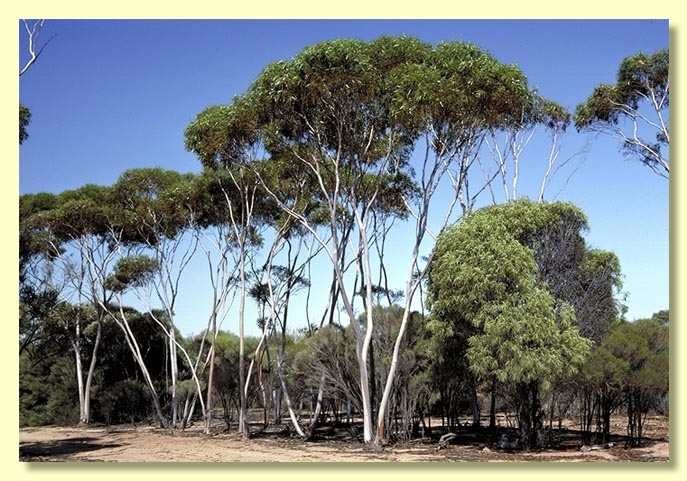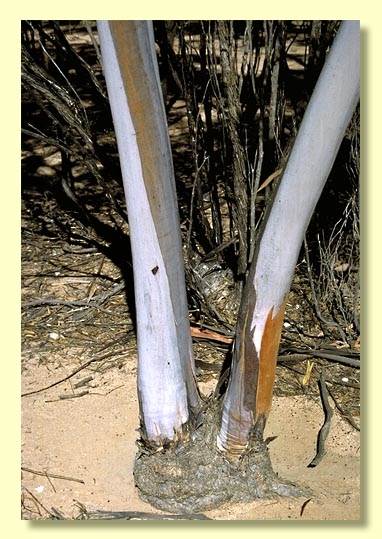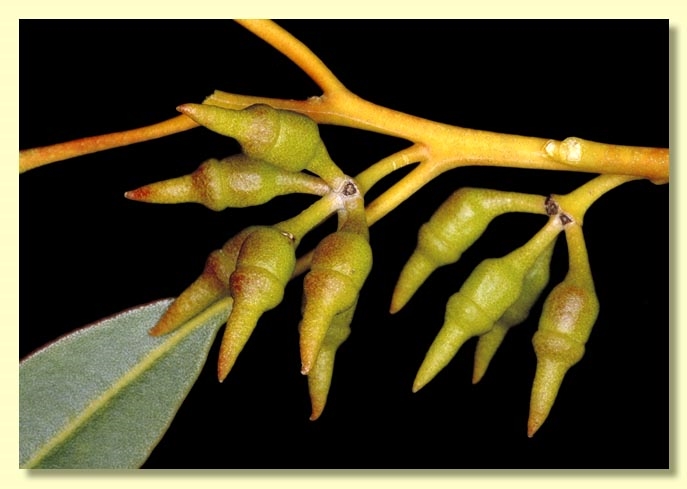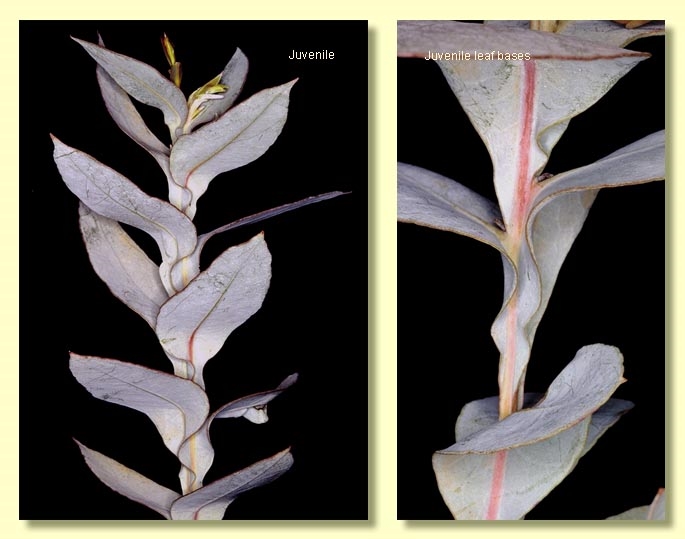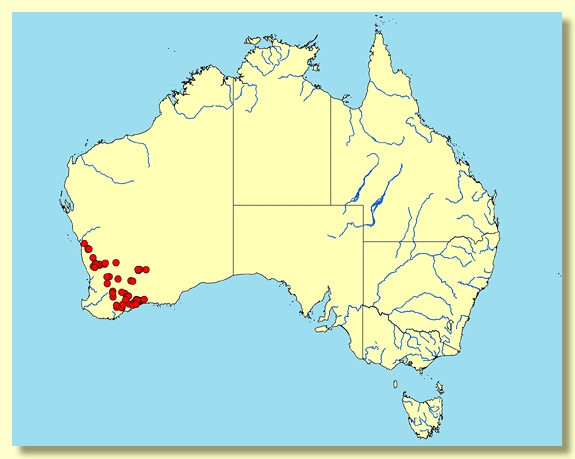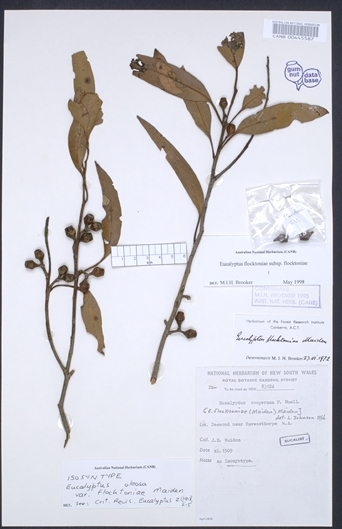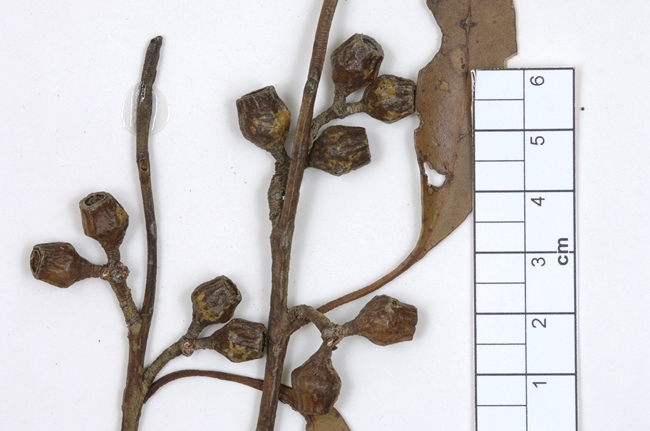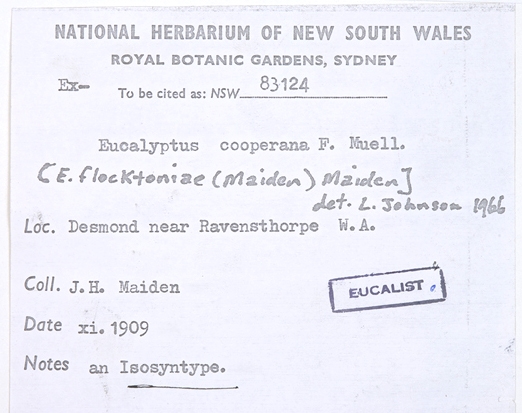Euclid - Online edition
Eucalyptus flocktoniae subsp. flocktoniae
Eucalyptus | Symphyomyrtus | Bisectae | Destitutae | Subulatae | Decurrentes
E. oleosa var. flocktoniae Maiden, J. Western Australian Nat. Hist. Soc. 3: 172 (1911). T: Western Australia: Desmond, near Ravensthorpe, Nov. 1909, J.H.Maiden s.n.; lecto: NSW; isolecto: CANB, K.
Bark usually smooth throughout, grey over creamy brown to coppery orange, occasionally with a small amount of ribbony rough bark at the base.
Branchlets lacking oil glands in the pith.
Juvenile growth (coppice or field seedlings to 50 cm): stem square to rounded in cross-section, sometimes slightly winged due to decurrent leaf bases, non-glaucous to slightly glaucous; juvenile leaves opposite becoming alternate further up the stem, sessile to shortly petiolate, elliptical to ovate to lanceolate, bases on lower leaves decurrent on stem, becoming rounded to tapering further up the stem, margin entire, apex pointed, 4–7.5 cm long, 1.5–2.5 cm wide, blue-green to slightly glaucous.
Adult leaves alternate, petiole 1–2.2(2.5) cm long; blade lanceolate to falcate, 6–11(12) cm long, 0.8–2(2.5) cm wide, base tapering to petiole, concolorous, glossy green, side-veins at an acute or wider angle to midrib, moderately to densely reticulate, intramarginal vein parallel to and just within margin, oil glands island to intersectional.
Inflorescence axillary unbranched, peduncles (0.4)0.6–1.5 cm long, erect to pendulous; buds usually 7 or 9, rarely 11 per umbel, pedicels 0.3–0.6 cm long. Mature buds ovoid to oblong and prominently beaked (1.1–1.8 cm long, 0.4–0.6 cm wide), not glaucous, hypanthium sometimes slightly ribbed, scar present, operculum beaked to horn-shaped (0.7–1.2 cm long), sometimes wider than the hypanthium at the join, stamens mostly inflexed, anthers versatile, basifixed, globoid, dehiscing by slits, style long, stigma tapered, locules 3 or 4, the placentae each with 4 vertical ovule rows. Flowers pale yellow to white.
Fruit erect to down-turned, pedicellate (pedicels 0.2–0.5 cm long), barrel-shaped to urn-shaped or rarely truncate-globose, 0.7–1 cm long, (0.5)0.6–0.9 cm wide, disc descending, valves 3 or 4, valve tips strongly exserted due to fragile style remnants.
Seeds glossy brown to grey, 1.5–2.2 mm long, ovoid or flattened-ovoid, rarely pointed at one end, occasionally with shallow longitudinal furrows on otherwise smooth dorsal surface, hilum ventral.
Cultivated seedlings (measured at node 10): cotyledons Y-shaped (bisected); stems square in cross-section and prominently winged due to decurrent leaf bases; leaves opposite, sessile, linear for the first few nodes then linear to ovate to elliptical, dull grey-green, 1.3–3 cm long, 0.5–2.5 cm wide, leaf base decurrent on stem.
Flowering has been recorded in January, February, March, April, August, October and December.
Eucalyptus flocktoniae is a mallee species widespread in the south-west of Western Australia from Mingenew north of Perth south-east to the Ravensthorpe area, extending east to Balladonia. The bark is smooth and the adult leaves slightly glossy to very glossy, dark green to bluish green. The buds and twigs lack visible white wax and the hypanthium of the buds and fruit lacks ribbing. The juvenile leaves are opposite for many pairs and strongly decurrent.
It belongs in Eucalyptus subgenus Symphyomyrtus section Bisectae subsection Destitutae because buds have two opercula, cotyledons are Y-shaped and branchlets lack oil glands in the pith. Within this subsection E. flocktoniae is part of a large taxonomic series Subulatae further characterised by globoid basifixed anthers, grey smooth seeds with shallow longitudinal furrows, and fruit with persistent exserted style remnants. Series Subulatae is divided principally into four subseries based on the juvenile leaves: one with spiral, crowded seedling phyllotaxis (subseries Spirales), another with decussate and decurrent seedling leaves (subseries Decurrentes), another with decussate non-decurrent seedling leaves (subseries Decussatae), and a fourth with disjunct, petiolate seedling leaves (subseries Oleaginae).
Eucalyptus flocktoniae is part of subseries Decurrentes.
The flocktoniae complex was revised Dean Nicolle in 1999 and three additional related species were recognised, viz. E. urna from Lake Grace to Caiguna, a mallet lacking a lignotuber and with extreme sculpturing of the pendulous buds and fruit; E. neutra from the Corrigin – Jerramungup – Lake King area, a mallee with slightly pruinose branchlets and inflorescences and bluish green adult leaves; and E. peninsularis from Eyre Peninsula in South Australia which is a mallee close to E. urna differing in the habit and presence of a lignotuber.
There are two subspecies:
E. flocktoniae subsp. flocktoniae
This has glossy green, immature and mature adult leaves. It is the more widespread subspecies and occurs from Mingenew to the Stirling Range and the Ravensthorpe area.
E. flocktoniae subsp. hebes
This has a more robust habit than subsp. flocktoniae and blue-green adult leaves, both immature and mature. It occurs from Balladonia west to Queen Victoria Rock, and north of Esperance.

